Recent Conferences
01-03 July 2011
Stefan Heym – von Chemnitz in die Welt' im TIETZ
Studierende des Seminars "Stefan Heym and his Exile Novels", das im Sommersemester 2011 am Lehrstuhl Anglistische Literaturwissenschaft der TU Chemnitz stattgefunden hat, haben sich mit einer Auswahl von Romanen und Kurzgeschichten Heyms beschäftigt und haben diese mit Hilfe eines zu Beginn der Lehrveranstaltung entwickelten Exil-Konzeptes diskutiert. Neben der theoretischen Fundierung, die eine intensive Auseinandersetzung der literarischen Texten Heyms ermöglichte, zeichnete sich das im Rahmen des Master-Moduls Cultural Representations in/and Practice durchgeführte Seminar durch einen starken Praxisbezug aus. Unter der Leitung von Prof. Dr. Cecile Sandten haben die Seminarteilnehmer im Laufe des Semesters eine praktische Projektarbeit durchgeführt, die abschließend auf der 1. Internationalen Stefan-Heym-Konferenz präsentiert und diskutiert wurde.
Diese Projektarbeit beinhaltete die Konzeption und kreative Umsetzung von wissenschaftlichen Postern, die die Studierenden in kleinen Gruppen zu jeweils einem ausgewählten Thema erarbeitet haben. Es handelte sich hierbei um eine Präsentationsform, die zunehmend auf Konferenzen angeboten wird, um mit Hilfe einer visuellen Umsetzung von wissenschaftlichen Fragestellungen erste Projekt-Ideen vorzustellen. Das gewonnene Feedback dient der Weiterentwicklung der Posterdarstellung in Textform.
Basierend auf den im amerikanischen Exil in englischer Sprache entstandenen Romanen Stefan Heyms (Hostages, The Crusaders, die Kurzgeschichtensammlung Defoe Against the Queen oder die Filmadaption des Romans Lenz, oder die Freiheit), haben die Seminarteilnehmer/innen eine eigenständig aufgestellte literaturwissenschaftliche These graphisch umgesetzt und auf der Konferenz eine wissenschaftliche „Ausstellung“ konzipiert: Auf flexibel zu arrangierenden Stellwänden waren die großformatigen Poster in Szene gesetzt worden. Jede Projekt-Gruppe hat ihr jeweiliges Poster in einem Kurzvortrag am Samstag Nachmittag erfolgreich präsentiert und die darin aufgezeigten Kernfragen und deren visuelle Konzeptualisierung erläutert. Ziel dieses Praxis-Projektes war es, studentische Arbeiten aus dem universitären Seminarkontext zu lösen und sowohl einem Fachpublikum als auch der breiten Öffentlichkeit vorzustellen.
Ergebnisse:
Bilder der Konferenz
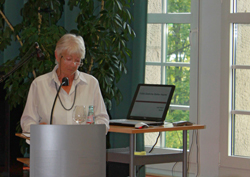
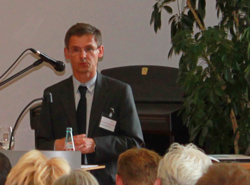
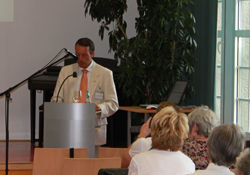
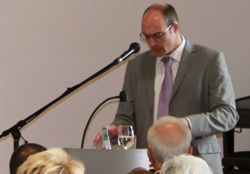
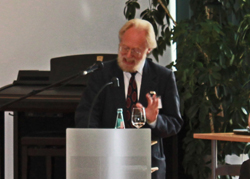
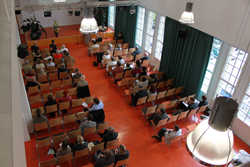
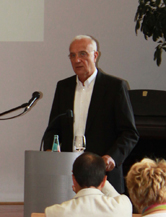
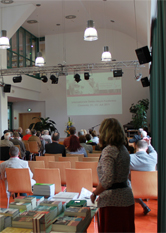
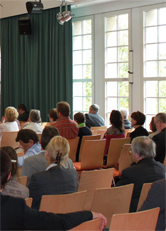
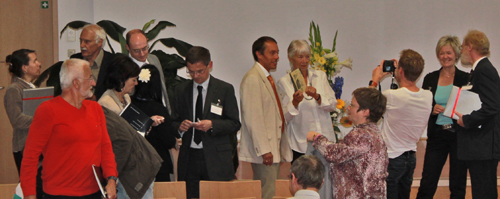

19-20 June 2009
Symposium: "Listen with the Eye - See with the Ear ...: 400 Jahre Shakespeare Sonette"
| Freitag, den 19. Juni 2009 | |
| 16.00 – 16.15 Karls Brauhaus, Brückenstraße 17 |
Begrüßung |
| 16.15 – 17.45
Karls Brauhaus, Brückenstraße 17
|
Ausstellungsbesuch der Gemälde und graphischen Blätter von Christina Stadler (Thüringen) und Diskussion bei einem kleinen Imbiss; Einführung durch die Künstlerin |
| 18.15 – 19.30 Altes Heizhaus, Str. der Nationen 62 |
Jürgen Gutsch (München), „Shakespeares Sonette weltweit“ |
| 20.00 Carolastraße 7 |
Harald Linke (Chemnitz), Szenenfolge „Shakespeare - medial vertauscht“ Kleinkunsttheater Fata Morgana |
| Samstag, den 20. Juni 2009 Altes Heizhaus, Str. der Nationen 62 |
|
| 09.30 – 10.15 | Roland Petersohn, „Shakespeares Sonette im Englischunterricht“ |
| 10.15 – 11.00 | Cecile Sandten, „Shakespeare exotisch: Die Sonette in Indien“ |
| Kaffeepause | |
| 11.15 – 12.00 | „Shakespeare’s Sonnets and Creative Writing: Students of English Literature present their Sonnets“ |
| 12.00 – 12.30 | Peter Harnisch (Dresden) & Jan Weinert (Berlin), Buchpräsentation William Shakespeare: Sonette. Deutsche Nachdichtung. |
| 12.30 – 12.45 |
Verabschiedung (Prof. Dr. Cecile Sandten) |
Images:
Fotos:
01-04, 06, 09-17, 19-20 Hans-Joachim Hermes
05, 07, 08, 18 Jan Schmiedel
“Giving a Voice to the Voiceless”: A Report on “Chotro-2: Nomadic Communities in the Post-Colonial World: Culture-Expression-Rights”, January 4 – 7 2009 at the Adivasi Academy, Tejgadh, Gujarat, India
After the overwhelming response to Chotro-1 at Delhi in January 2008 - the first conference on a global scale devoted to indigenous peoples around the world, their histories, languages, literatures, cultures - it went without saying that there would be another Chotro conference which was already announced at the first one. But this year, it did not take us to another Indian megacity but to one of the remotest places you could think of for such a ‘global’ conference: Chotro-2 was held at the ‘Adivasi Academy’, founded by the initiator of the conference, Ganesh Devy, with the aim of educating and, thus, empowering the Adivasi communities. The academy is situated in Tejgadh, a tribal village in Gujarat, Western India, two hours from Baroda, the city where we all met first before being brought to this unique conference venue by the most helpful and well-organised team of the ‘Bhasha Research and Publication Centre’, Baroda. The latter was also established by Ganesh Devy, in order to document the cultural practices of the Advasis.
But before I go on to describe my still incredibly vivid memories of Chotro-2, it seems inevitable to define what exactly the term “chotro” implies as the idea behind the Chotro conference addresses a completely different form of conference – going way beyond the usual academic agenda. In many varieties of the Bhili language group, “chotro” means “a place where villagers gather”, “a public platform”, “a centre for dispute resolution” and “a place for announcing news”. Therefore, Chotro-2 has aimed to “bring together” writers, artists and scholars from all over the world, to explore the artistic expression of the nomadic peoples, and their experience of becoming disinherited and dispossessed due to historical, legal, political, linguistic or cultural processes.
And this is exactly what we had during the next three most intense and inspiring days, due to the conference venue at Tejgadh, a very special place where you can really have “chotro” in terms of spirituality, work, inspiration and creativity. The latter was, again and again, literally practiced by dint of having the participants seated in a circle. What, at first, might have seemed unusual, that is sitting barefoot on the ground in a half-circle on mattresses and cushions, contributed to the unique atmosphere of the paper presentations as these were rather exchanges of ideas than the commonly practised mode of giving papers. In consequence, this led to a most valuable dialogue between speaker and listeners, a situation that would not have been possible in a lecture hall.
The papers covered a wide range of thematic approaches as the speakers came from various fields of study and nations, but as different as they might have seemed at first, the papers had one and the same intention that corresponds to the overall idea of Chotro: giving a voice to the voiceless. Yet, there were also critical voices that raised an important question that is inevitable to ask yourself when discussing tribal culture, history, language and literature: Who can speak as ‘other’? Are we allowed to do so? Even though it is difficult to respond to such complex questions with a simple “yes” or “no”, the engagement in indigenous communities, the mere talking about their dispossessed cultures and traditions, is no doubt a big step forward in making their silenced voices heard, as many of them are still not in the position to do so on their own. Therefore, it is appropriate to understand Chotro primarily in terms of an empowering polyphony of voices.
This is one main reason why Chotro is so different from other conferences: it is not just about presenting papers and discussing abstract and theoretical issues but rather about making a political statement in a world where capitalism has already got into the remotest parts of the world. In papers on Nomadic communities in India, Africa, or the Caribbean, on Nigerian society with special regard to the Igbo tribes, on marginalised communities, as for instance in Kenya and Zimbabwe, Aboriginal peoples in Australia and New Zealand, or on slum-dwellers, just to mention a few among the rich range of presentations, it became clear that new concepts such as transculturality are far-fetched and only work on a theoretical level. The notion of the post-colonial is more relevant than ever and the struggle of the dispossessed to come to terms with what has been taken from them by the colonisers is still an on-going process.
Chotro is in many respects a global gathering of different voices, not only in terms of the variety of (silenced) voices discussed but also in terms of their contributors. One evening we again literally did “chotro” as all contributors came together in a circle of chairs outside the academy and Ganesh Devy asked us about our mother tongues. In the end, we literally came full circle adding up a total of over 30 different languages which also hints at the polyphonic character of Chotro. During the course of the conference, the importance of language was again and again put forward as tribal identity can only be preserved if the respective languages and literatures are placed at the forefront (actually, one section was entirely dedicated to the Global Language Mission). However, tribal literary traditions, which have been oral in nature, were generally neglected by print technology and therefore, the need for publishing indigenous texts was frequently stressed throughout the conference.
In a way, this has been achieved by the publication of the first Chotro-1 proceedings entitled Indigeneity: Culture and Representation, which was launched on the last day of Chotro-2 as the papers that were included not only document the spirit of Chotro-1, but rather give a voice to the voiceless by making their stories, their narratives and languages, public knowledge. This remarkable collection of essays, edited by K. K. Chakravarty, Geoffrey Davis and Ganesh Devy and published by Orient BlackSwan, is dedicated to “The indigenous peoples in all continents who know that they belong to the earth, not that the earth belongs to them” which basically sums up Chotro’s overall message. Some of the contributors were again with us, so that they were able to receive their personal copy handed over to them by Geoffrey Davis. This was a very special moment not only for those involved in the volume but for all participants present that morning. Due to the overwhelming response to Chotro-1, there will be a second selected volume of papers presented in Delhi. In addition, Moving Worlds has already published selected papers in a special Chotro issue of the journal.
Nevertheless, I have to stress again that Chotro is not only about presenting and publishing academic works. Ganesh Devy and his Bhasha team pursue a political vision in preserving language, culture, space, and environment of the Adivasi. It is this holistic concept that was taken up by Prof. Suhrud Tridip, an Ahmedabad based academic and member of the Board of Advisors of the Adivasi Academy at Tejgadh, who gave a lecture on “The Ashram in Mahatma Gandhi's Imagination“ on our visit to the Sabarmati Ashram of Mahatma Gandhi at Ahmedabad. Altogether, Chotro also focuses on the Gandhian ideas of work, spirituality and political empowerment.
Thus, it is the political dimension that makes Chotro such an important gathering on a global scale. Because of this, its conferences cannot be understood as separate events, but rather as a process that has to be carried on. And indeed, Chotro-1 and 2 were only the beginning. There are more conferences to come: Chotro-3 will be held at a location that cannot be ignored, as it is impossible to be overlooked. It will be located in the highest museum of the world, the ‘Lahaul & Spiti Tribal Museum’, at Keylong, in the Himalayas. Due to Chotro’s overall intention, its conferences have to be different – and this does not only refer to their unique venues. But without the continuous, creative and committed work of the organisers, it would not have been possible to get such a conference going. At this point, we would very much like to thank Ganesh Devy, Geoffrey Davis, the Bhasha team and everyone involved in organising this conference for making Chotro-2 such an inspiring experience for all of us. I guess that we could all, in our own way, take some of Chotro’s ideas home with us. The spirit of Chotro-2 has even triggered plans to spread the Chotro message over to another continent: Chotro-4 will be held in Kenya, Africa and thus literally carries its implied processual character across borders, boundaries, and spaces. But first, let’s have another “chotro” in the Himalayas in September 2010!
Birte Heidemann (Chemnitz Technical University, Germany)




















